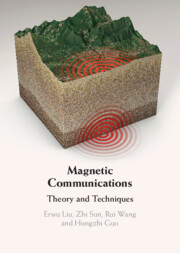Book contents
4 - Metamaterial-Enhanced Magnetic Communications
from Part I - Introduction and Properties of MI
Published online by Cambridge University Press: 04 January 2024
Summary
In preceding chapters, we have shown reasons by analyzing the power generated by the magnetic dipole antenna and devising the pathloss model by using the equivalent circuit model. Due to the high path loss, the magnetic communication range is very limited. On the one hand, this can be leveraged to enable secure short-range wireless communications, e.g., near-field communication. On the other hand, magnetic communication cannot be used for many important applications that require a long communication range. In this chapter, we first introduce the magnetic waveguide, which starts from the fundamental analysis of its structure and magnetic field propagation in the air. Then, we extend the discussion to extreme environments and show the range extension. Next, we introduce the metamaterial-based solutions. The spherical metamaterial-resonance structure is analyzed using advanced electromagnetic theory. After that, we present an approach to implement the spherical metamaterial structure. The enhancement is demonstrated by using numerical analysis and experimental measurements.
- Type
- Chapter
- Information
- Magnetic CommunicationsTheory and Techniques, pp. 63 - 84Publisher: Cambridge University PressPrint publication year: 2024

